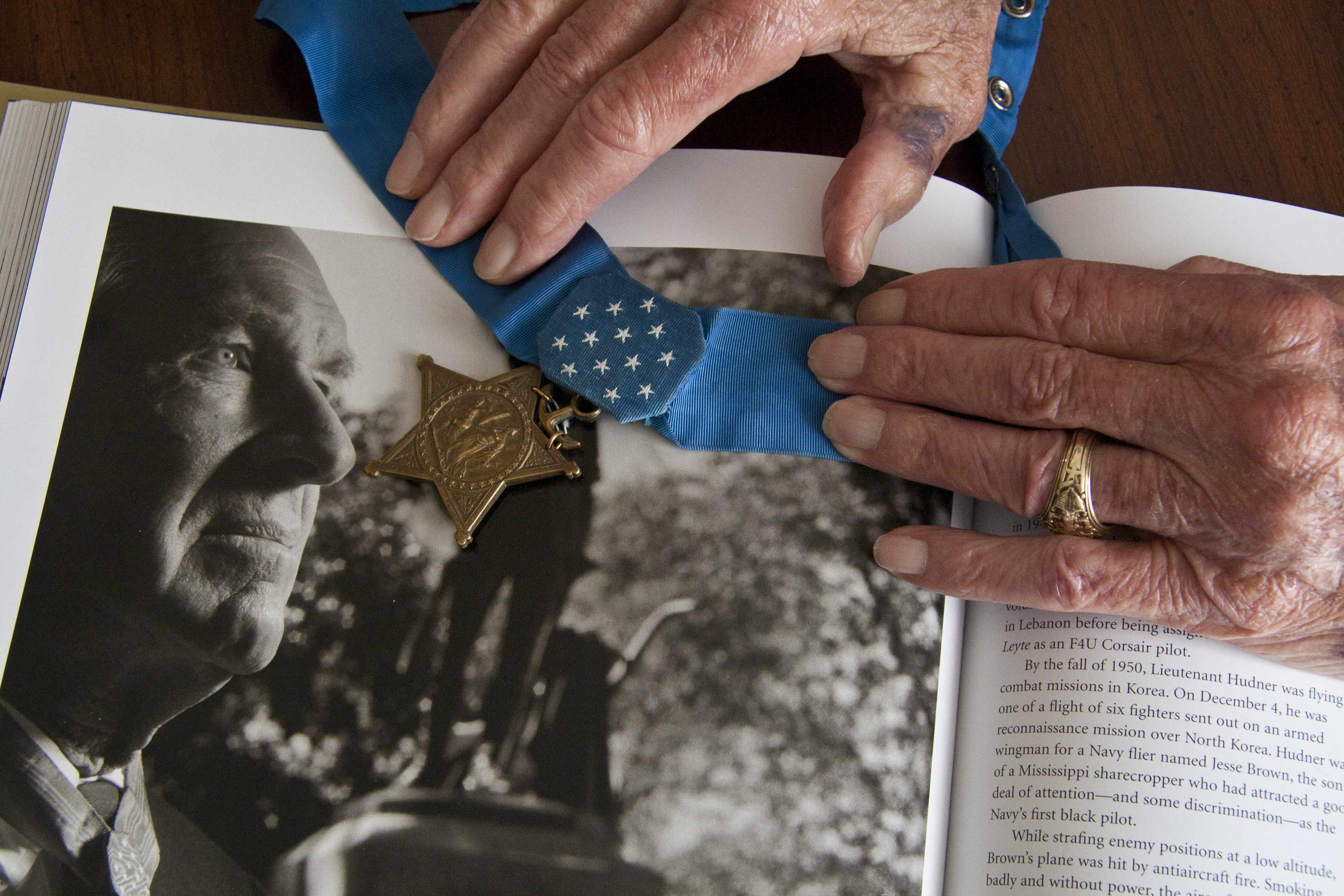According to Linn’s Stamp News, the U.S. Postal Service has adequate supplies of last year’s stamps. In the past, new designs for these subjects have been issued whenever there wasa rate change – even after these issues became Forever stamps that could be used before and after a rate change.
Monthly Archives: July 2014
Christmas Magi
Linn’s Stamp News reports this is the “traditional” Christmas issue this year. It will be a double-sided pane of 20 in the convertible booklet format. No design has been released yet. Holiday stamps are often released at the ASDA show in New York; that would be October 23rd or 24th.
Rudolph the Red-Nosed Reindeer
Linn’s Stamp News reports that is, indeed, the subject of the “contemporary” Christmas issue this year. There is no word yet on how many stamps are in this issue, but recent past contemporary Christmas issues have had four designs.
No first-day date was announced, but holiday stamps are often released at the ASDA show in New York; that would be October 23rd or 24th.
Linn’s points out that the Rudolph animated television special debuted on December 6, 1964, making this the 50th anniversary of the TV show. But the song itself was released in 1949, recorded by Gene Autry. (The lyrics, as a poem, had been used the previous year as advertising for the Montgomery Ward chain of department stores.)
The newspaper says this will be a double-sided pane of 20 in a convertible-booklet format.
Photos: Korean War Medal F.D. Ceremony
Photographs from Korean War Medal of Honor First Day Ceremony
July 26, 2014, Arlington National Cemetery
These photographs are by Daniel Afzal of the U.S. Postal Service.  Before the first day ceremony, Larry Kinard, President, Korean War Veterans Association and The honorable Kim Jung Hoon, Representative of National Assembly of the Republic of Korea, lay a wreath.
Before the first day ceremony, Larry Kinard, President, Korean War Veterans Association and The honorable Kim Jung Hoon, Representative of National Assembly of the Republic of Korea, lay a wreath.
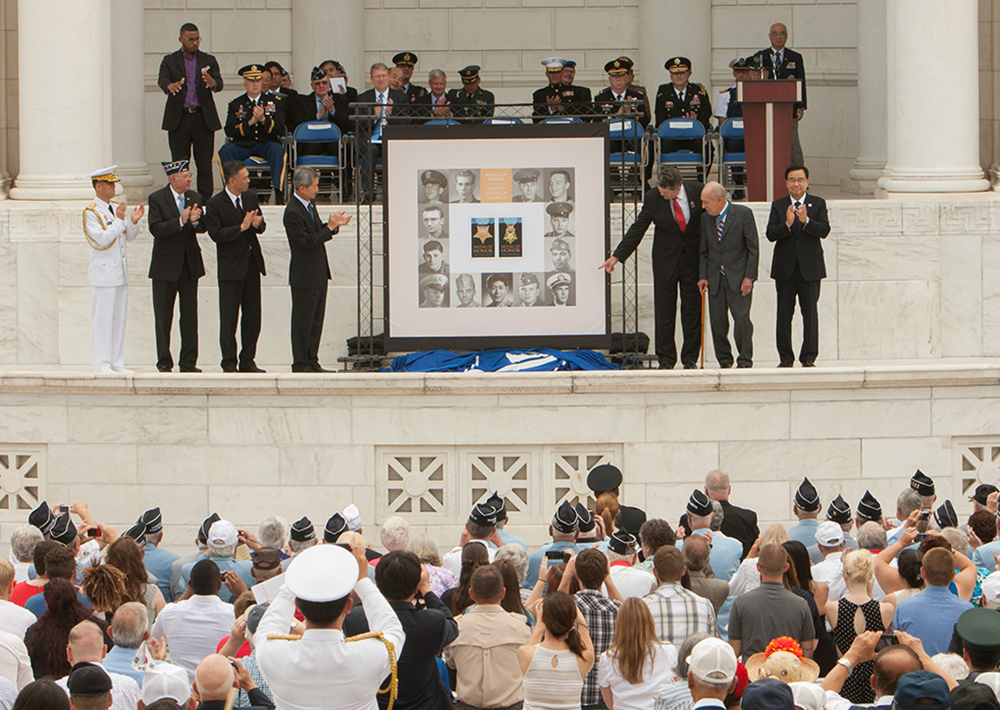 After the unveiling of the stamps, Postmaster General Patrick Donahoe points out to Captain Thomas J. Hudner, Jr. the Medal of Honor recipient’s portrait (bottom right hand corner) on the blowup. Hudner is one of nine living Medal of Honor recipients from the Korean War. Thirteen are shown in the stamp booklet, but four passed away before the stamps could be issued.
After the unveiling of the stamps, Postmaster General Patrick Donahoe points out to Captain Thomas J. Hudner, Jr. the Medal of Honor recipient’s portrait (bottom right hand corner) on the blowup. Hudner is one of nine living Medal of Honor recipients from the Korean War. Thirteen are shown in the stamp booklet, but four passed away before the stamps could be issued.
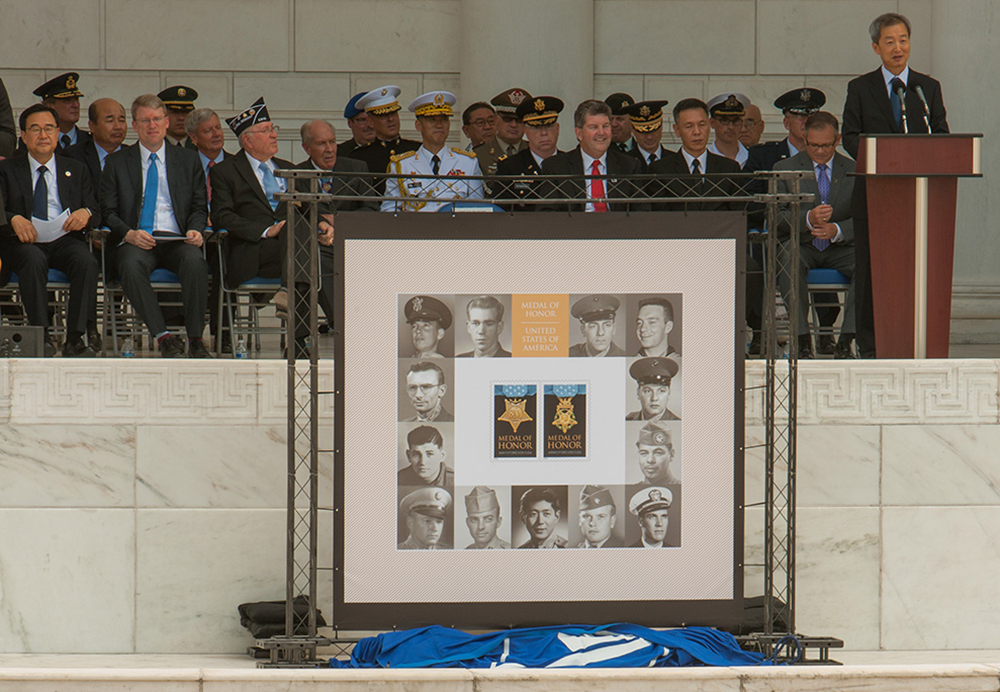 His Excellency Ahn Ho-young, Ambassador of the Republic of Korea to the United States of America, speaks during the first day ceremony.
His Excellency Ahn Ho-young, Ambassador of the Republic of Korea to the United States of America, speaks during the first day ceremony.
 Postmaster General Donahoe with Hudner and his wife Georgea.
Postmaster General Donahoe with Hudner and his wife Georgea.
Details about the stamps can be found here.
These photographs are by Mark Saunders of the USPS:
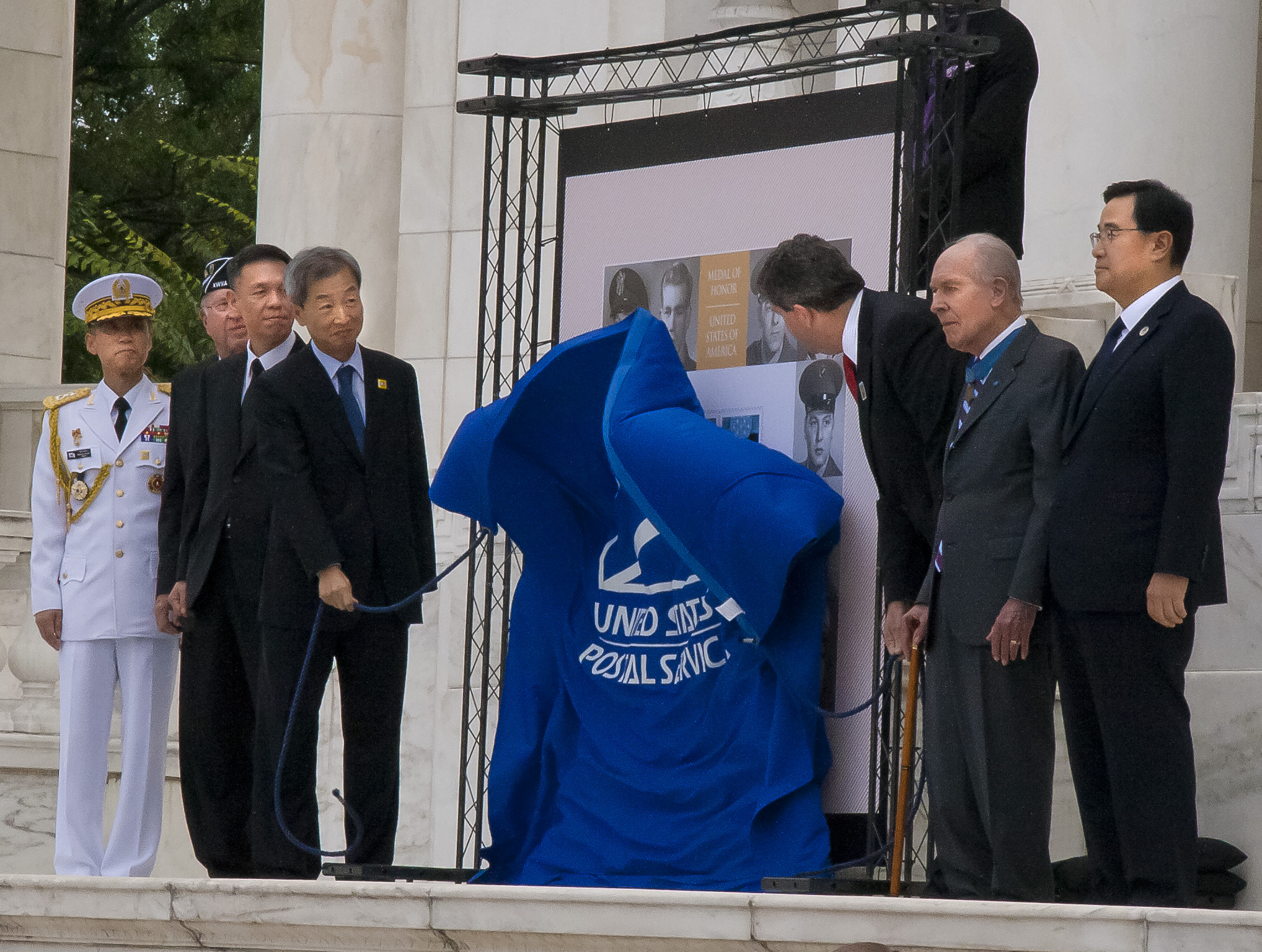
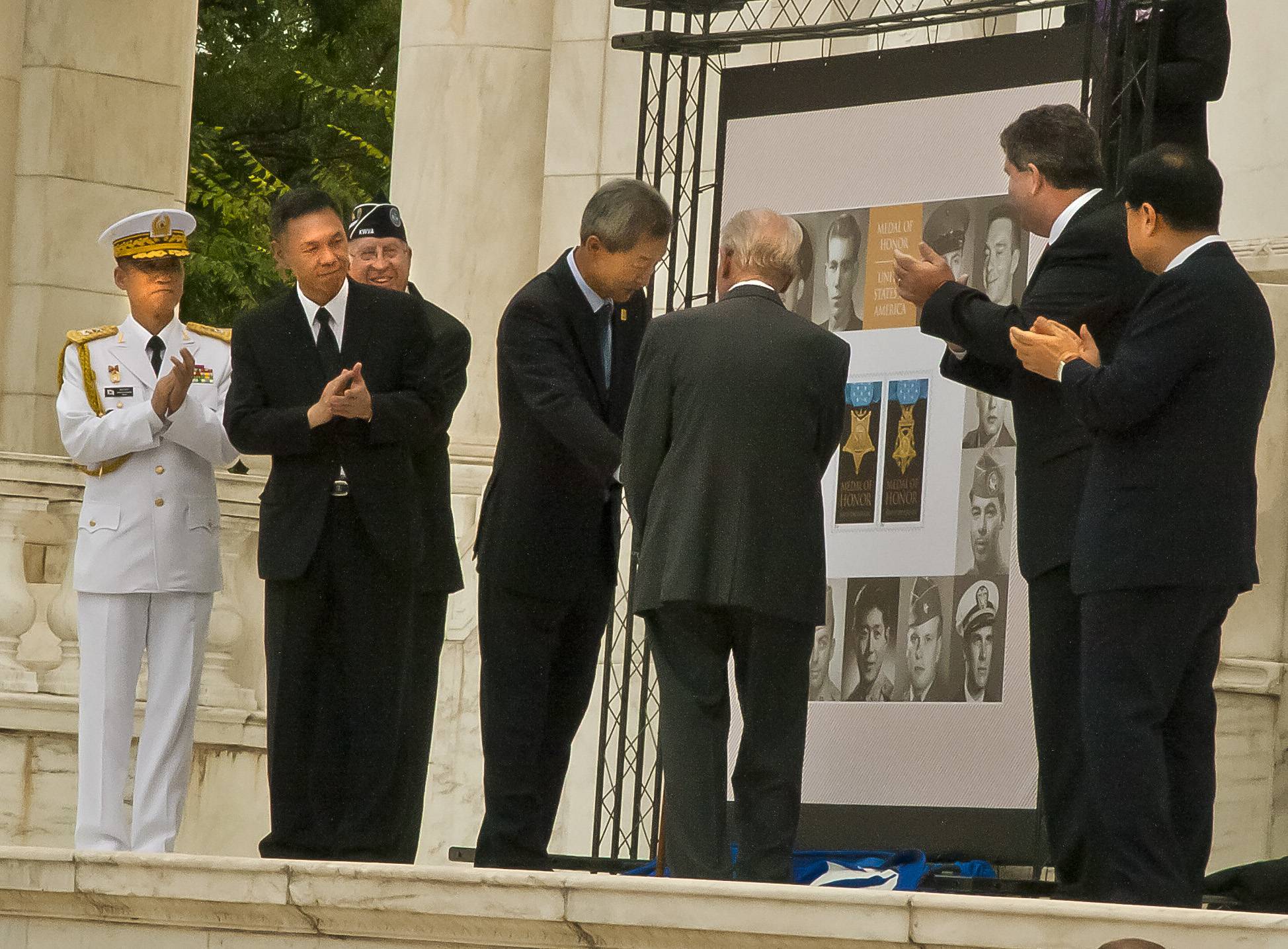
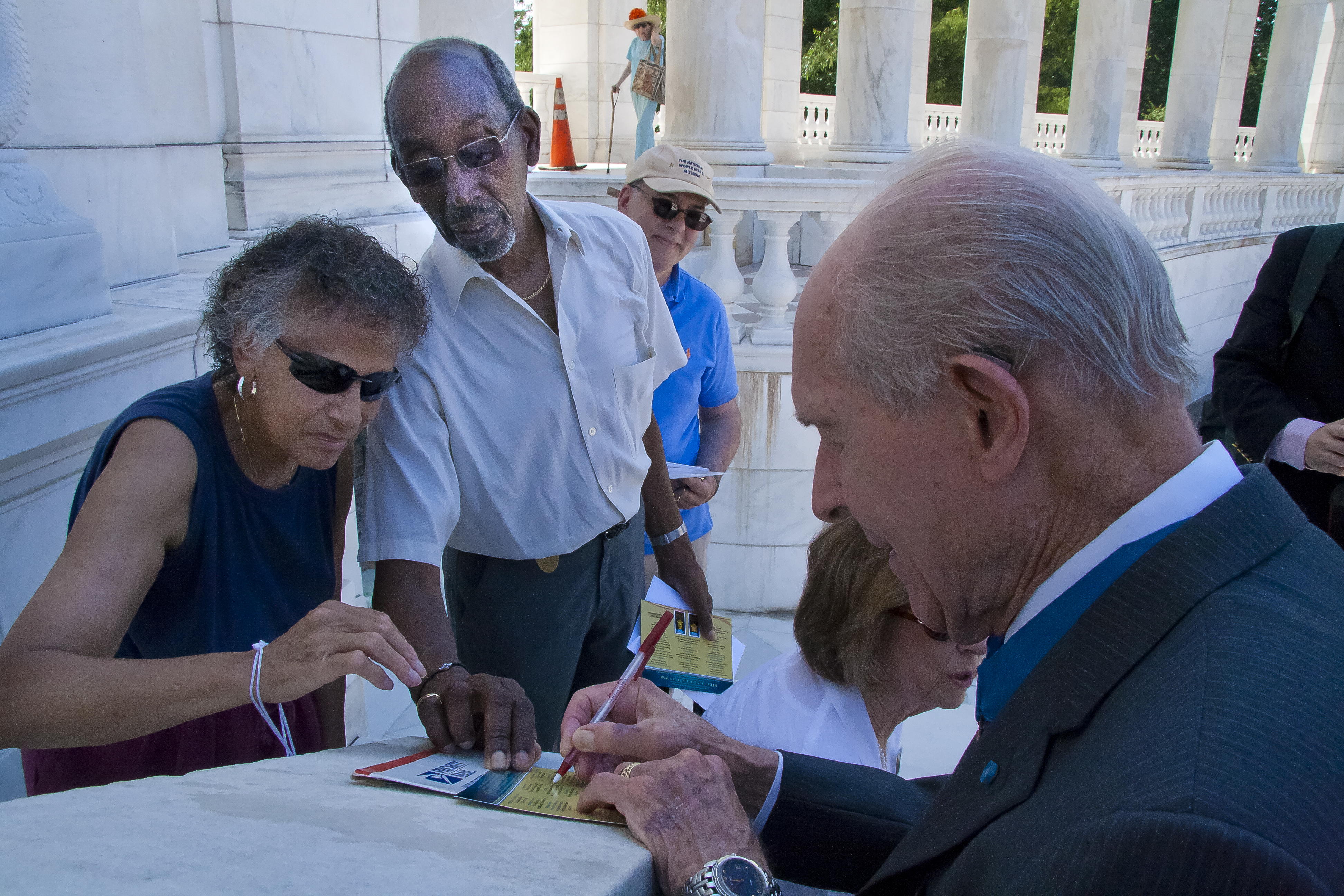 Capt. Thomas J. Hudner, Jr., of Concord, Mass., signed autographs after the ceremony. Mark spent some time before the ceremony with Capt. Hudner, the only living recipient who attended the ceremony:
Capt. Thomas J. Hudner, Jr., of Concord, Mass., signed autographs after the ceremony. Mark spent some time before the ceremony with Capt. Hudner, the only living recipient who attended the ceremony:
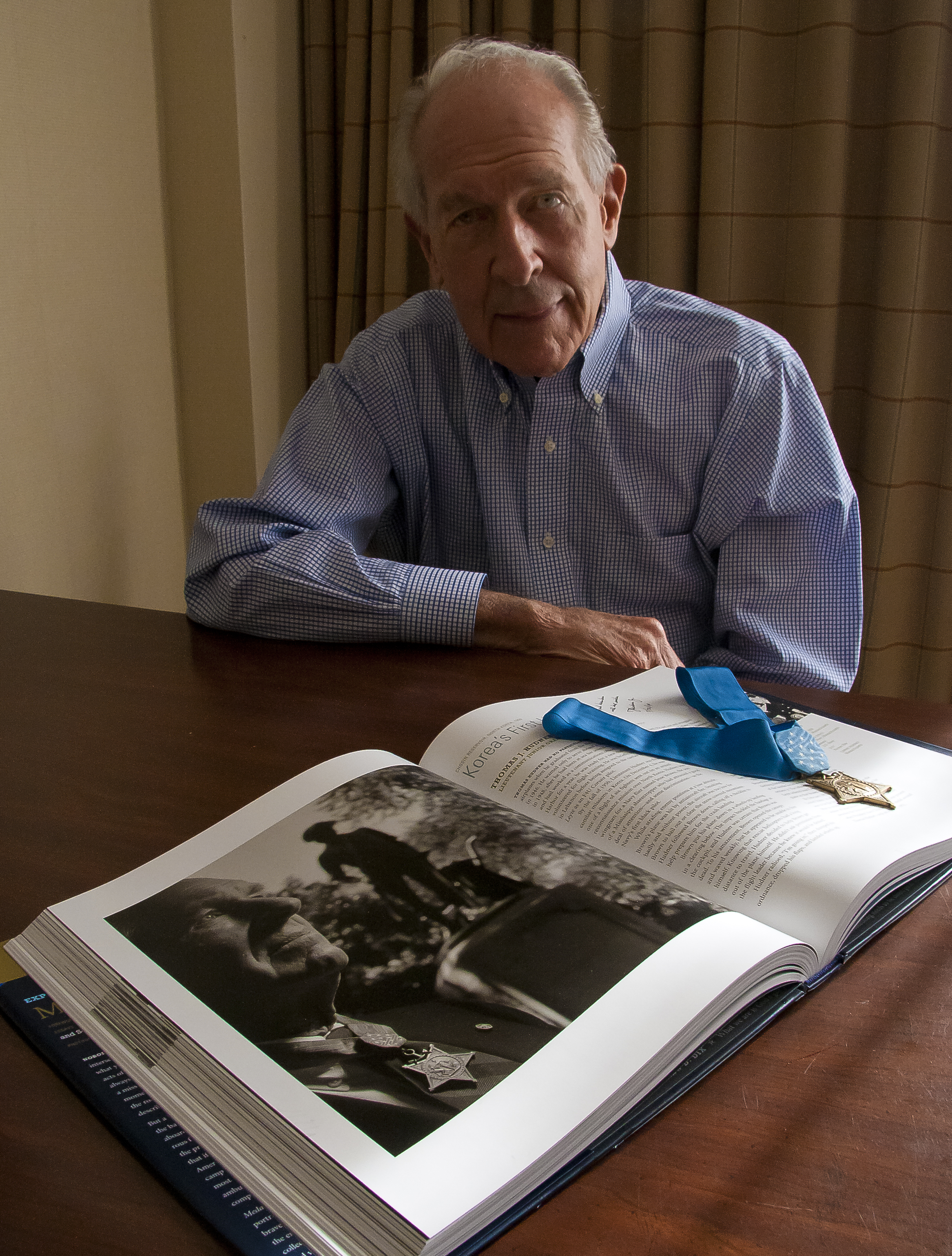
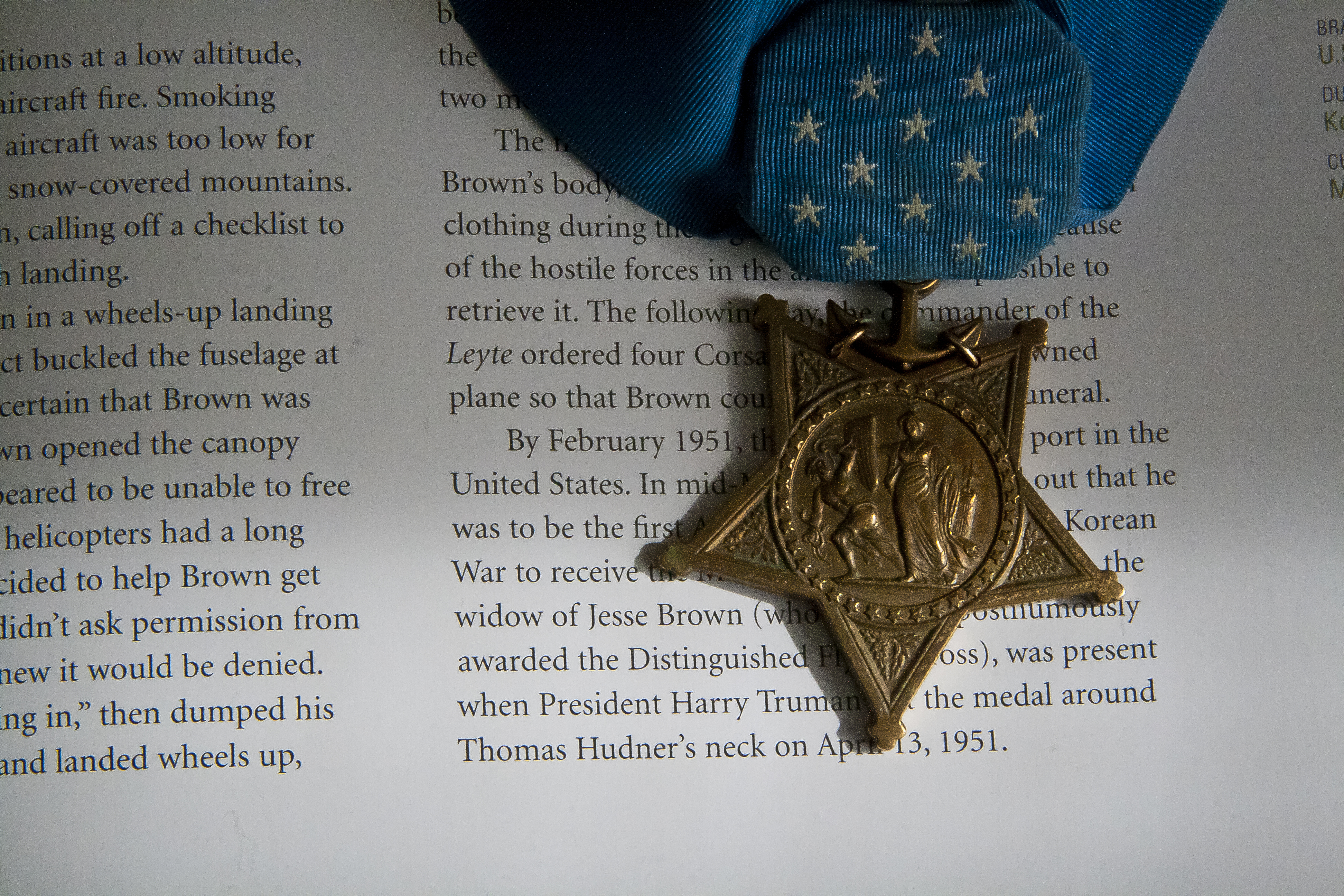 (Look at the last line of text in the book, and you can see Hudner’s name.)
(Look at the last line of text in the book, and you can see Hudner’s name.)
Piazza Is NPM’s New Stamp Chief
[press release]
National Postal Museum Selects Daniel Piazza as New Chief Curator of Philately
 The Smithsonian’s National Postal Museum announces the selection of Daniel A. Piazza to the position of chief curator of philately and chair of the philately department.
The Smithsonian’s National Postal Museum announces the selection of Daniel A. Piazza to the position of chief curator of philately and chair of the philately department.
As chief curator of philately, his responsibilities will include curating a permanent collection of approximately 6 million stamps and related artifacts; object selection and script writing/review for permanent and temporary exhibitions; representing the museum through presentations and attendance at professional conferences; collections-based research and writing; and seeking and acquiring items of outstanding significance for display and research purposes.
“We enjoy a great reputation for having exceptional curators at the helm of our philately department, and Daniel continues that tradition,” said Allen Kane, director of the museum.
Piazza joined the museum staff in 2007 as the inaugural Winton M. Blount chair in research. He became assistant curator of philately in 2008 and curator in 2011.
The museum’s William H. Gross Stamp Gallery features work curated by Piazza, including 6 linear videos, “Treasures of the World” exhibition, (45 world-class philatelic rarities from 24 countries) and “On Land and Sea” exhibition (methods for moving mail on land and sea, including significant groupings of 14th–18th-century letters and RMS Titanic postal artifacts).
Piazza also co-curated with Cheryl R. Ganz “Fire & Ice: Hindenburg and Titanic,” (March 22, 2012–Jan. 6, 2014) and “Delivering Hope: FDR & Stamps of the Great Depression,” (Sept. 9, 2009–June 6, 2010)
Piazza is currently curating “Freedom Just Around the Corner: Black America from Civil War to Civil Rights,” a chronicle of the African American experience, as told from the perspective of stamps and mail. The temporary exhibition open Feb. 12, 2015–Feb. 12, 2016, will include letters carried by enslaved Americans, mail to and from famous leaders of the civil rights movement and a significant selection of original artwork for the USPS Black Heritage stamp series from the Postmaster General’s Collection.
Piazza is also the author of a regular column, “National Postal Museum Treasures,” in Linn’s Stamp News and is president and chairman of NAPEX, one of the country’s largest annual stamp shows.
The National Postal Museum is devoted to presenting the colorful and engaging history of the nation’s mail service and showcasing one of the largest and most comprehensive collections of stamps and philatelic material in the world. It is located at 2 Massachusetts Avenue N.E., Washington, D.C., across from Union Station. The museum is open daily from 10 a.m. to 5:30 p.m. (closed Dec. 25). For more information about the Smithsonian, call (202) 633-1000 or visit the museum website at www.postalmuseum.si.edu.
Hotchner: Organizing Covers
Maintaining A Cover Collection: Organization Is Everything
by John M. Hotchner
 My friend Doug Quine poses this question: “One of the great challenges in philately to me is that a cover (or article) that I collect today for an interesting stamp, postmark, or usage may prove to be of interest tomorrow because of its auxiliary marking. How do you manage to seemingly have your massive collection and reprints organized in such a way that when a new item appears you instantly know when you last saw it and how many you have?”
My friend Doug Quine poses this question: “One of the great challenges in philately to me is that a cover (or article) that I collect today for an interesting stamp, postmark, or usage may prove to be of interest tomorrow because of its auxiliary marking. How do you manage to seemingly have your massive collection and reprints organized in such a way that when a new item appears you instantly know when you last saw it and how many you have?”
Doug seems to think I have mastered this particular devil. But given that at least once a month I dig for something I know I have and can’t find it immediately, I’m not so sure. There are, however, processes I’ve developed to minimize the problem, and I’m happy to share them.
The first is based on the assumption that file folders are cheaper than losing things.
I’m going to use as my example for this piece my Auxiliary Markings (AM) collection. AMs are the messages usually in purple hand stamps pre-1980, and often on computer paste-ons since, that tell us why the Postal Service has not been able to handle a letter as routine — leaving it damaged, undelivered, delayed, in need of more postage, or suffering from any of dozens of other problems.
I began accumulating them in the 1970s — examples, often free or inexpensive — went into a box. No need to organize at this point. But by the late ‘80s as children began going off to college followed eventually by weddings, I could no longer afford to feed existing collections and needed something cheap to play with. Down from the shelf came that AM accumulation.
To make a long story short, over the next 15 years that box of covers developed into a Gold and Grand Award winning exhibit, the source of inspiration for many articles, and the basis for founding, with Doug’s help, the Auxiliary Markings Club.
In the process, the collection supporting the exhibit grew in volume to fill six Xerox boxes.
The exhibit began by covering the entire 100 years of the 20th century. Over ten years, the amount of material needed to illustrate the period covered dictated a reduction in scope from 100 years to 75, and then from 75 to 50, and the present form of the exhibit just covers 1900-1949.
I’m hopeful that time and health will allow for preparation one day of a parallel exhibit covering 1950-1999 delayed mail. And I have not ruled out an exhibit for 2000-2025 (by which time I will have turned 82!) The result is that I’m actively accumulating candidates for those exhibits, as well as trying to improve the existing exhibit.
If covers were the only thing to organize, store and access, the challenge would be difficult enough. But there is another dimension because there is no single reference for information about delayed and undeliverable mail. So my horde of covers is augmented by something over 2,500 clippings, articles, printouts of Post Office rules, and images of covers in other collections and from auction catalogs.
This is needed to support research to explain the covers in the collection, and practices that acted on the covers in the exhibit. And it is also essential background for my writings in Linn’s, LaPosta, and other venues, as well as to answer questions from readers.
Bottom line: This mass of material demands a high level of organization so that I can find things. How to do that? There is a process.
The first sort for incoming material, be it covers or information, is into one of four boxes labeled Pre-1900, 1900-1949, 1950-1999, and 2000+. As time permits and necessity dictates, these boxes periodically get sorted into file folders labeled by time period and for the type of delay. For example, each time period has folders for Transportation Delays, Postage Due From Sender, Postage Due From Addressee, Natural Disasters (which can be subdivided into Earthquakes, Hurricanes, and Floods) Delays, Damage in the Mails, and much more.
It may be evident that one cover or clipping could fit into more than one folder. So, in addition to fat file folders being subdivided into ever more specific categories, there is a need to cross-index by writing on the folders a note about where else to look for a specific item. An example would be “See also Suspended Mail Service” on the “War Covers” folder.
This can get to outlandish proportions as with the category of “Inability to Deliver the Mail” which for 1900-1949, where most of my work is concentrated, now subdivides into 28 subcategories including for example, “Deceased,” “No Such City in State Named,” “Signature Refused,” “Addressee Gone Away,” etc.
This system works for me, but it is not enough by itself. For 1900-1949 there is also a folder for “Candidates for the exhibit” and another for “Information to update the exhibit”.
Of course there are also other complications: Articles in progress require gathering of a group of covers and information on the desired subject into a clear plastic page protector, which goes into the appropriate “pending drafting box” for one of the nine publications to which I regularly contribute.
Those packets may take six to nine months to be translated into article form and be published. And once sent off to a publication, the pending article and its support materials go into a separate pending file. With all these places to look, is it any wonder things get “lost,” at least temporarily?
I can say with a straight face that I have a pretty good memory. I know if I have seen a marking, if I have it, and if I have information about it. And if something is not where it is supposed to be, I may or may not recall what I may have done with it, but I do generally know where else to look. It may be in the exhibit, in one of the pending files, in the primary sort box, in the current correspondence file, or (rarely) in a big box of stuff that I have declared excess and available for trade or sale.
There has even been the occasional misfile. So it comes down to this: There is no perfect system, even as there is no perfect human. But if one is willing to devote the significant amount of time to developing and using a logical system of organization, almost everything can be located because the alternative locations where it can be found are limited and defined.
So, Doug, I hope this helps you and others.
Immoderate Moderation
 nce upon a time, in the early days of the Internet, when “14-4” was considered fast and pictures in discussion groups were nonexistent, there were two major stamp collecting discussion groups.
nce upon a time, in the early days of the Internet, when “14-4” was considered fast and pictures in discussion groups were nonexistent, there were two major stamp collecting discussion groups.
One was a Usenet newsgroup, based on the Internet (which relatively few people knew how to access), the other an e-mail “list.”
The newsgroup, called rec.collecting.stamps, was not only free of cost, but free of rules. As with e-mail, it didn’t take long for the hucksters to discover how easy it was to “spam” a group with get-rich-quick schemes and too-good-to-be-true offers, some of which were related to philately, but only some.
It was also a “wild west show,” in that, with no moderators nor rules, anyone could say anything, about any subject. Or anyone. Just as many drivers become bold and brave (in their eyes) or obnoxious and aggressive (others’ eyes) when hiding within their half-ton motorized cocoons, RCS and other Internet users discovered they could be anonymous, with no repercussions for anything they posted.
Soon the newsgroup split, into rec.collecting.stamps.discuss for discussions, another for sales pitches, a third for postal history and maybe others. However, people soon began to leave for more civilized discussion groups. RCSD may still exist today — I haven’t checked in years — but it’s just a few dozen people, if that many.
The other group, in e-mail, was based at Penn State, although I think its physical proximity to American Philatelic Society headquarters was a coincidence. At first, it too was free: Whatever was e-mailed to the group’s address went out immediately to the group.
Then one day, the owner/moderator became disgusted with some of the messages, and  decided to clamp down: From that point on, no messages could be posted until he approved them. The problem with that was that if he was busy, or sleeping, or otherwise occupied, the messages might stack up and not be distributed. And the moderator began to lose interest, which meant the delay got longer and longer and…
decided to clamp down: From that point on, no messages could be posted until he approved them. The problem with that was that if he was busy, or sleeping, or otherwise occupied, the messages might stack up and not be distributed. And the moderator began to lose interest, which meant the delay got longer and longer and…
Last time I checked, which was a few years ago, the list was still operating: You could send a message to it, and in a week or so, the message would be distributed to the members of the list… if there are any. If anyone still cared about the message after several days in limbo.
The point is that over-moderation can kill an online discussion group, and under-moderation can do it in, too. It’s a delicate balance, and that focal point doesn’t stay put; it moves around. There is no formula.
But like a playground seesaw, staying at one end or the other doesn’t make for much of a ride.
—Lloyd A. de Vries
App for U.S. Postal Museum
National Postal Museum’s Launches Free iPhone/iPad App
App Brings Exhibit Objects to Life
 The Smithsonian’s National Postal Museum launched a new app that brings exhibit objects to life. MagnifiAR is an augmented reality app for the iPhone and iPad that allows museum visitors to unlock additional layers of interpretive content for select artifacts in two of the museum’s exhibitions — ”Pacific Exchange: China & U.S. Mail” and “Mail by Rail.” After downloading the free app from Apple’s iTunes Store, visitors point the camera of their mobile device at select exhibit objects and images. The fun, interactive and family-friendly app highlights stamps, artwork and artifacts that trigger video footage, images, trivia and games to connect visitors to exhibit objects in meaningful ways.
The Smithsonian’s National Postal Museum launched a new app that brings exhibit objects to life. MagnifiAR is an augmented reality app for the iPhone and iPad that allows museum visitors to unlock additional layers of interpretive content for select artifacts in two of the museum’s exhibitions — ”Pacific Exchange: China & U.S. Mail” and “Mail by Rail.” After downloading the free app from Apple’s iTunes Store, visitors point the camera of their mobile device at select exhibit objects and images. The fun, interactive and family-friendly app highlights stamps, artwork and artifacts that trigger video footage, images, trivia and games to connect visitors to exhibit objects in meaningful ways.
 In “Pacific Exchange: China & U.S. Mail,” an exhibit that looks at the relationship of the two countries through the study of stamps and mail, visitors can go on a safari hunt and bring animals to life. Finding seven specific exhibit objects will unlock surprising information and unexpected fun. Locating the Chinese Giant Panda stamps from 1973 connects visitors to the National Zoological Park’s two live panda cams to witness Mei Xiang, Tian Tian and baby cub Bao Bao in their cozy habitat. Discovering the Chinese black-necked crane stamp launches a video of the cranes performing exotic dances. The U.S. Postal Service’s 2012 Year of the Dragon artwork brings to life a Chinese Lunar New Year dragon dance. Visitors can also discover which animal corresponds to their year of birth by locating the 37-cent Year of the Rabbit Chinese New Year artwork from 1999.
In “Pacific Exchange: China & U.S. Mail,” an exhibit that looks at the relationship of the two countries through the study of stamps and mail, visitors can go on a safari hunt and bring animals to life. Finding seven specific exhibit objects will unlock surprising information and unexpected fun. Locating the Chinese Giant Panda stamps from 1973 connects visitors to the National Zoological Park’s two live panda cams to witness Mei Xiang, Tian Tian and baby cub Bao Bao in their cozy habitat. Discovering the Chinese black-necked crane stamp launches a video of the cranes performing exotic dances. The U.S. Postal Service’s 2012 Year of the Dragon artwork brings to life a Chinese Lunar New Year dragon dance. Visitors can also discover which animal corresponds to their year of birth by locating the 37-cent Year of the Rabbit Chinese New Year artwork from 1999.
“This new app encourages families to engage with exhibit artifacts in a fun new way at the National Postal Museum,” said Allen Kane, director of the museum.
“Mail by Rail,” an exhibit where visitors explore the story of the Railway Post Office, allows visitors to experience life on the rail in the early 20th century. Postal clerks aboard the mail cars could sort 600 pieces of mail per hour. When visitors point their device at one of the enlarged photos in the railway mail car, a video will launch showing how mail clerks sorted mail aboard a train.
Instead of stopping at every small town to transfer the mail, railway mail trains were fitted with catcher arms that snatched mailbags off of cranes. Visitors can view a 1908 silent black-and-white film demonstrating how “mail-on-the-fly” worked by pointing their device at the train catcher arm on display in the exhibit. Viewed through the app, the exhibit’s “Mail by Rail” sign brings to life Owney the dog, the unofficial mascot of the Railway Post Office in the late 1800s, who invites visitors into the exhibit’s railway mail car.
Visitors without an Apple device or smartphone may check-out an iPod Touch at the museum’s information desk (valid photo identification required) to explore the new app. “The museum is always working to improve the visitor experience, and new technologies allow for new opportunities,” said K. Allison Wickens, museum education director. “Even if you are at home, you can use our new app to bring the animal stamps in our China exhibit to life by pointing your mobile device at our website from your own computer screen!”
The National Postal Museum is devoted to presenting the colorful and engaging history of the nation’s mail service and showcasing one of the largest and most comprehensive collections of stamps and philatelic material in the world. It is located at 2 Massachusetts Avenue N.E., Washington, D.C., across from Union Station. The museum is open daily from 10 a.m. to 5:30 p.m. (closed Dec. 25). For more information about the Smithsonian, call (202) 633-1000 or visit the museum website at www.postalmuseum.si.edu.
Dick Sine: The Value of Your Stamp Collection
The Value of Your Stamp Collection
by Richard L. Sine
 Go figure! Literally. How do you arrive at the “value” of your collection? That is not as simple as question as it may appear. Just what “value” are you going to consider?
Go figure! Literally. How do you arrive at the “value” of your collection? That is not as simple as question as it may appear. Just what “value” are you going to consider?
- Catalog value
- Market value
- Replacement value
- Resale value
They are not the same. So let’s e-value-ate the terms.
Catalog value is determined by the publisher of a given catalog. Some publishers tell you how that is determined and some don’t. When I was at Scott Publishing, the definition of catalog value was the price you would expect to pay for a given stamp at a specific grade when purchased as a single item. I don’t know if that definition continues today, but it appeared to work then.
Getting to that value, however, is the key. Those of you around at the time may remember the stir Scott caused around 1980 when it changed its internal approach to reaching “catalog value.” Before arriving at the changed approach, we even employed the services of a retired mathematician as a consultant. After reviewing our data, he opined that the best we had, given how few data points for nearly all items, was “fuzzy numbers.” You can see how that term would stick with me after about 35 years.
Also, there is the concept of minimum value, i.e., the least catalog value at which any stamp is valued. While that value ostensibly considers the cost to a dealer to handle a stamp, each time it is raised by five cents boosts the “value” of many collections (mine included) by a bunch. (Note, “bunch” is not a technical term.)
Market value is the least definable of the group. It can reflect any ups and downs of stamp value, or the difference in value in different parts of the world. A highly specialized collection of U.S. stamps probably Is worth more in this county than in Germany. As for market ups and downs, I remember when, over a period of a few months, the market value of a set of mint U.S. Zeppelin air mail stamps dropped from something like $13,500 to $2,700 each. I was at Scott at the time and remember the gasp of an investor/speculator at the other end of a phone call when I told him the current value … he had something like 17 sets.
Replacement value is what you would pay to replace your current collection with stamps of identical quality. It may differ widely from catalog value, because you would have the benefit of purchasing in quantity, i.e., another collection or partial collection or by the set … all rather than by the individual stamp. This term comes up if a collection is stolen or destroyed in a fire or flood.
Resale value is where the possibility of a sharp kick in the heads occurs. Perhaps you want to sell your collection … yes, some collectors do that. And, let’s further presume that you are not one of the very few collectors who has a rather small collection of items that perhaps you have exhibited … thus, they each are of rather high catalog value and perhaps exceed the quality level at which catalog value is set. Then, you can expect what may well be a shockingly low offer for your material. This statement is not designed to be critical of any dealers, or stamp dealers as a whole. It is reality.
Remember the mention above about catalog minimum value, which is set to recognize what it costs a dealer to handle the most inexpensive items. This is the other side of that coin (sorry about mixing hobbies a bit). That is, 1,000 stamps with a minimum value of 25 cents each DO NOT have a market value of $250. Thus, being offered 10-15% of catalog value for a collection may not be unreasonable, no matter how much it insults your philatelic macho instincts.
Why this discussion in the first place? A whole lot of stamp collections become part of estates on the death of their owners. Heirs have heard their beloved fathers/mothers/uncles/aunts talks about the “value” of a collection over the years. When an heir attempts to sell that windfall, the purchase offer will not cover the cost of a new automobile to drive home … but, rather, may barely cover an airplane ticket. And, that is why I have known more than a few collectors, late in life, who have sold their own collections rather than bring on stress-caused-by-reality to others.
There are times when we stamp collectors must take a step back from our wonderful world of philately and into the real world to be certain there is someone in the family who understands just what “value” there is in our collection. It is important to have a complete inventory of the collection. My inventory is in a 352 kb Excel spreadsheet file.
That somber thought aside, let’s return to our regularly scheduled collecting practice and go buy a lot of stuff.
USPS’ Staples Plan Is Shelved
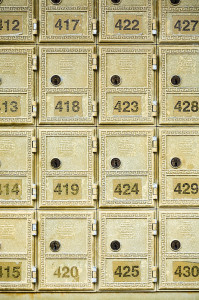 Office supply chain Staples and the U.S. Postal Service are ending a pilot program to put postal counters inside Staples stores that would have been staffed by non-union Staples employees. The decision comes just a few days after the country’s biggest teachers union called for a boycott of Staples, just as the lucrative back-to-school buying season was beginning.
Office supply chain Staples and the U.S. Postal Service are ending a pilot program to put postal counters inside Staples stores that would have been staffed by non-union Staples employees. The decision comes just a few days after the country’s biggest teachers union called for a boycott of Staples, just as the lucrative back-to-school buying season was beginning.
There had also been protests outside some stores recently.
There are articles about the cancellation of the program in The Wall Street Journal and on Reuters.

